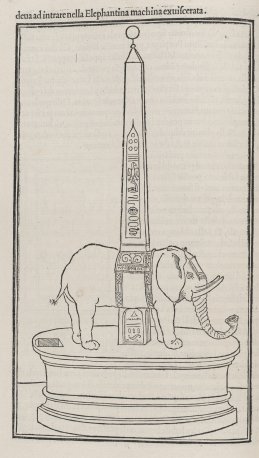Hypnerotomachia Poliphili
Hieroglyphs
Hypnerotomachia Poliphili [ edit ]
Francesco Colonna, Hypnerotomachia Poliphili (Venice: Aldus Manutius, 1499)
During the Middle Ages, Western scholars engaged in a scholastic dialogue, attempting to reconcile Christian theology and the teachings of the Greek philosopher Aristotle (Aristotelianism), based on readings and subsequent discussions (disputationes). During the fourteenth century, particularly Italian scholars popularized the search for the most ancient versions of known texts, and looked for copies of others lost and neglected as insignificant for scholasticism. They abandoned the architecture and scripts of the Middle Ages, and introduced what we call the Renaissance.
Renaissance scholars not only studied ancient monuments—they also invented new symbols that they deemed “hieroglyphs.” One example appears in Francesco Colonna’s Hypnerotomachia Poliphili “The Strife of Love in a Dream.” The main character Poliphio awakens in a dream world filled with ancient ruins, including Egyptian-inspired monuments such as this obelisk and elephant. The obelisk is inscribed with “Egyptian characters beautifully drawn.” This design later inspired the Italian artist Bernini to create a statue ensemble in which the elephant and obelisk together symbolized (as the Latin inscription on its base states): “You, whoever you are, who see that the figures of wise Egypt engraved on the obelisk are borne by the elephant, strongest of beasts, understand it as proof that to uphold sound wisdom is the part of the sturdy mind.”
Not unlike the joys and scientific speculation on interplanetary travel in the later science fiction tale Somnium, by Johannes Kepler (written between 1620-1630), Colonna employed fiction to reveal some of the fact and more of the psychic joy of antiquarianism and archaeology. According to the title page: poliphili hypnerotomachia, ubi humana omnia non nisi somnium esse ostendit, atque obiter plurima scitu sanequam digna commemorat. “The Dream Strife of Love of Poliphilo, wherein all human things are revealed to be ought but a dream, and other things worth both knowing and remembering.”
Summary of the Hypnerotomachia Poliphili:
The Hypnerotomachia Poliphili relates a dream within a dream. Poliphilo—Lover of all things—tries to sleep, tormented by the rebuff of his love, polia—all things. Finally at dawn Poliphilo falls asleep, and begins to dream his both idyllic and phantasmagoric dream.
In a forest the thirsty Poliphilo finds a stream that he likens to Indian, Mesopotamian, and Egyptian rivers. Hearing a Doric song, he falls asleep beneath an oak tree, and dreams within the initial dream.
In the second dream he awakens in a landscape of fantastic architecture, including Egyptian, Classical, and imaginary elements. Inscriptions invented by the author appear on drawings of monuments—some in realistic disrepair—that provide cryptic clues to Poliphilo, and to the reader as well. Poliphilo meets nymphs, falling in love with one of them, who reveals herself as his true love, Polia—all that he loves. Poliphilo’s descriptions of the monuments and the nymphs are equally erotic and lush—we come to realize that he loves Antiquity. Poliphilo and Polia encounter five triumphal processions celebrating their union—Poliphilo’s love of antiquity has indeed allowed him, at least in a dream, to enter the world of antiquity. The lovers travel to the island of Cythera, and a second narrative—Polia’s description of her experience of the Hypnerotomachia—enters the text. Then Poliphilo describes the joys of their wedding; when he embraces Polia at the end, however, she vanishes with a farewell—he cannot fully possess, but he can sensually experience, antiquity.
Date
1499
Artist or Author
Francesco Colonna
Provenance
Italy
Museum
Beinecke Rare Book Library
Accession Number
Zi +5574 (Copy 2)












